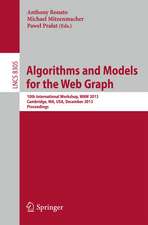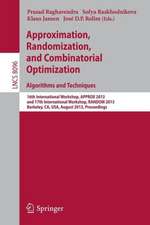Handbook on Data Management in Information Systems: International Handbooks on Information Systems
Editat de Jacek Blazewicz, Wieslaw Kubiak, Tadeusz Morzy, Marek Rusinkiewiczen Limba Engleză Hardback – 15 iul 2003
| Toate formatele și edițiile | Preț | Express |
|---|---|---|
| Paperback (1) | 1286.10 lei 6-8 săpt. | |
| Springer Berlin, Heidelberg – 20 iul 2012 | 1286.10 lei 6-8 săpt. | |
| Hardback (1) | 1292.40 lei 6-8 săpt. | |
| Springer Berlin, Heidelberg – 15 iul 2003 | 1292.40 lei 6-8 săpt. |
Din seria International Handbooks on Information Systems
- 18%
 Preț: 974.19 lei
Preț: 974.19 lei - 20%
 Preț: 1068.02 lei
Preț: 1068.02 lei - 18%
 Preț: 1241.90 lei
Preț: 1241.90 lei -
 Preț: 411.26 lei
Preț: 411.26 lei - 18%
 Preț: 1249.93 lei
Preț: 1249.93 lei - 20%
 Preț: 2213.67 lei
Preț: 2213.67 lei - 20%
 Preț: 1930.26 lei
Preț: 1930.26 lei - 20%
 Preț: 1301.78 lei
Preț: 1301.78 lei - 20%
 Preț: 1295.21 lei
Preț: 1295.21 lei - 18%
 Preț: 1847.84 lei
Preț: 1847.84 lei - 20%
 Preț: 1294.36 lei
Preț: 1294.36 lei - 24%
 Preț: 1051.19 lei
Preț: 1051.19 lei - 18%
 Preț: 1226.24 lei
Preț: 1226.24 lei - 18%
 Preț: 1389.30 lei
Preț: 1389.30 lei - 18%
 Preț: 962.03 lei
Preț: 962.03 lei - 18%
 Preț: 1554.05 lei
Preț: 1554.05 lei - 18%
 Preț: 1554.23 lei
Preț: 1554.23 lei - 18%
 Preț: 1234.94 lei
Preț: 1234.94 lei - 18%
 Preț: 968.03 lei
Preț: 968.03 lei - 18%
 Preț: 2331.12 lei
Preț: 2331.12 lei - 15%
 Preț: 600.90 lei
Preț: 600.90 lei - 18%
 Preț: 1576.04 lei
Preț: 1576.04 lei - 47%
 Preț: 1130.29 lei
Preț: 1130.29 lei - 9%
 Preț: 1117.37 lei
Preț: 1117.37 lei
Preț: 1292.40 lei
Preț vechi: 1615.51 lei
-20% Nou
Puncte Express: 1939
Preț estimativ în valută:
247.33€ • 268.56$ • 207.76£
247.33€ • 268.56$ • 207.76£
Carte tipărită la comandă
Livrare economică 22 aprilie-06 mai
Preluare comenzi: 021 569.72.76
Specificații
ISBN-13: 9783540438939
ISBN-10: 3540438939
Pagini: 578
Ilustrații: IX, 578 p.
Dimensiuni: 155 x 235 x 37 mm
Greutate: 0.99 kg
Ediția:2003
Editura: Springer Berlin, Heidelberg
Colecția Springer
Seria International Handbooks on Information Systems
Locul publicării:Berlin, Heidelberg, Germany
ISBN-10: 3540438939
Pagini: 578
Ilustrații: IX, 578 p.
Dimensiuni: 155 x 235 x 37 mm
Greutate: 0.99 kg
Ediția:2003
Editura: Springer Berlin, Heidelberg
Colecția Springer
Seria International Handbooks on Information Systems
Locul publicării:Berlin, Heidelberg, Germany
Public țintă
ResearchCuprins
1. Management of Data: State-of-the-Art and Emerging Trends.- 1 Introduction.- 2 Survey of the Volume.- 2. Database Systems: from File Systems to Modern Database Systems.- 1 Introduction — Database Concepts.- 2 Database System Generations.- 3 Network Database Systems.- 4 Hierarchical Database Systems.- 5 Relational Database Systems.- 6 Object-Oriented Database Systems.- 7 Federated, Mediated Database Systems and Data Warehouses.- 8 Conclusions.- 3. Data Modeling.- 1 Introduction.- 2 Early Concerns in Data Management.- 3 Abstraction in Data Modeling.- 4 Semantic Data Models.- 5 Models of Reality and Perception.- 6 Toward Cognition-Based Data Management.- 7 A Cognitive Approach to Data Modeling.- 8 Research Directions.- 4. Object-Oriented Database Systems.- 1 Introduction and Motivation.- 2 Object-Oriented Data Modeling.- 3 The Query Language OQL.- 4 Physical Object Management.- 5 Architecture of Client-Server-Systems.- 6 Indexing.- 7 Dealing with Set-Valued Attributes.- 8 Query Optimization.- 9 Conclusion.- 5. High Performance Parallel Database Management Systems.- 1 Introduction.- 2 Partitioning Strategies.- 3 Join Using Inter-Operator Parallelism.- 4 ORE: a Framework for Data Migration.- 5 Conclusions and Future Research Directions.- 6. Advanced Database Systems.- 1 Introduction.- 2 Preliminaries.- 3 Data Models and Modeling for Complex Objects.- 4 Advanced Query Languages.- 5 Advanced Database Server Capabilities.- 6 Conclusions and Outlook.- 7. Parallel and Distributed Multimedia Database Systems.- 1 Introduction.- 2 Media Fundamentals.- 3 MPEG as an Example of Media Compression.- 4 Organisation and Retrieval of Multimedia Data.- 5 Data Models for Multimedia Data.- 6 Multimedia Retrieval Sequence Using Images as an Example.- 7 Requirements for MultimediaApplications.- 8 Parallel and Distributed Processing of Multimedia Data.- 9 Parallel and Distributed Techniques for Multimedia Databases.- 10 Case Study: Cairo — Cluster Architecture for Image Retrieval and Organisation.- 11 Conclusions.- 8. Workflow Technology: the Support for Collaboration.- 1 Introduction.- 2 Application Scenario and Collaboration Requirements.- 3 Commercial Technologies Addressing Collaboration Requirements.- 4 Evaluation of Current Workflow Management Technology.- 5 Research Problems, Related Work, and Directions.- 6 Summary.- 9. Data Warehouses.- 1 Introduction.- 2 Basics.- 3 The Database of a Data Warehouse.- 4 The Data Warehouse Concept.- 5 Data Analysis of a Data Warehouse.- 6 Building a Data Warehouse.- 7 Future Research Directions.- 8 Conclusions.- 10. Mobile Computing.- 1 Introduction.- 2 Mobile Computing Infrastructure.- 3 Mobile Computing Software Architectures and Models.- 4 Disconnected Operation.- 5 Weak Connectivity.- 6 Data Delivery by Broadcast.- 7 Mobile Computing Resources and Pointers.- 8 Conclusions.- 11. Data Mining.- 1 Introduction.- 2 Mining Associations.- 3 Classification and Prediction.- 4 Clustering.- 5 Conclusions.- List of Contributors.
Caracteristici
Gives a complete, up-to-date overview of the subject Includes supplementary material: sn.pub/extras






























